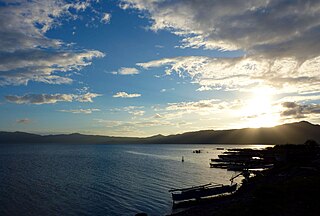
Caraga, officially the Caraga Administrative Region and designated as Region XIII, is an administrative region in the Philippines occupying the northeastern section of Mindanao. The region was created through Republic Act No. 7901 on February 23, 1995. The region comprises five provinces: Agusan del Norte, Agusan del Sur, Dinagat Islands, Surigao del Norte, and Surigao del Sur; six cities: Bayugan, Bislig, Butuan, Cabadbaran, Surigao and Tandag; 67 municipalities and 1,311 barangays. Butuan, the most urbanized city in Caraga, serves as the regional administrative center.

Lake Mainit is the fourth largest lake in the Philippines, having a surface area of 173.40 square kilometres (66.95 sq mi). The lake is also the deepest lake in the country with maximum depth reaching 223 metres (732 ft). It is located in the northeastern section of Mindanao and shared between the provinces of Surigao del Norte and Agusan del Norte.

Nepenthes bellii is a tropical pitcher plant endemic to the Philippine islands of Mindanao and Dinagat, where it grows at elevations of 0–800 m above sea level.

The ornamental orchid species Phalaenopsis hieroglyphica is native to certain islands of the Philippines. Its flowers are creamy white with transverse markings that resemble glyphs. Through hybridization, growers have successfully created flowers with different shapes and colors while retaining the glyphs. Since 1975, the species has been protected under Appendix II of the Convention on International Trade in Endangered Species of Wild Fauna and Flora (CITES).

The Philippine leafbird is a species of bird in the family Chloropseidae. It is endemic to the Philippines. It is found in the islands of Mindanao, Leyte, Samar and Cebu. Its natural habitat is tropical moist lowland forest. It is threatened by habitat loss.

The short-crested monarch is a species of bird in the family Monarchidae and one of the most attractive of all the monarch flycatchers. It is a brilliant ultramarine blue bird with the males having a black facial markings with an electric blue eyering and a short crest contrasted with a pearly white belly. It is endemic to the Philippines found on the islands of Luzon, Camiguin Norte, Polilio, Catanduanes, Samar, Dinagat and Mindanao. It is found in tropical moist lowland forest. It is threatened by habitat loss. Along with the Celestial monarch, It is one of the most sought after birds among birdwatchers.

Phalaenopsis micholitzii is a species of plant under the phylum Tracheophyta in the family Orchidaceae.This Orchid species is found in mainly four different places in the Philippines Islands. Those four places are Luzon Island, Mindanao, Zamboanga Peninsula and in Camarines Sur near the Isarog mountain.

Caladenia congesta, commonly known as black-tongue caladenia, is a plant in the orchid family Orchidaceae and is endemic to Australia. It is a ground orchid with a single, sparsely hairy leaf, and up to three bright pink flowers with the central part of the labellum completely covered with black calli. It is a widespread species but not common in any part of its range.

Dendrobium atroviolaceum is a species of epiphytic orchid endemic to eastern New Guinea. It was described by English botanist Robert Allen Rolfe in 1890 based on a specimen collected by James Veitch & Sons.

Paphiopedilum sukhakulii is a species of plant in the family Orchidaceae.

Cattleya rex is a species of epiphytic orchid of showy white flowers, native to montane forests in Peru and Bolivia.
Bulbophyllum nocturnum is a species of epiphytic orchid that grows in New Britain. It was described in 2011, and is the first species of orchid known to consistently flower during the night, and close its flowers during the day.
Agusan is a Manobo language of northeastern Mindanao in the Philippines.

Caladenia conferta, commonly known as the crowded spider orchid or coast spider-orchid, is a plant in the orchid family Orchidaceae and is endemic to a restricted area in South Australia. It is a ground orchid with a single hairy leaf, and usually a single yellowish-green flower with red markings on a wiry, hairy stalk.

Caladenia congesta, commonly known as black-tongue caladenia, is a plant in the orchid family Orchidaceae and is endemic to Australia. It is a ground orchid with a single, sparsely hairy leaf, and up to three bright pink flowers with the central part of the labellum completely covered with black calli. It is a widespread species but not common in any part of its range.

Dendrobium nindii, commonly known as the blue antler orchid, is an epiphytic or lithophytic orchid in the family Orchidaceae. It has erect, cylindrical, leafy pseudobulbs with leathery, dark green leaves and up to twenty mauve or violet flowers with darker veins on the labellum. This antler orchid occurs in tropical North Queensland and New Guinea.

Phalaenopsis natmataungensis is a species of orchid endemic to Myanmar. The specific epithet natmataungensis refers to Nat Ma Taung, Myanmar. The mountain slopes are covered in natural, seasonally dry forests that are mainly composed of deciduous trees. These areas are generally not disturbed by agriculture.

Dendrobium bensoniae is a species of orchid native to Asia. It was described by German botanist Heinrich Gustav Reichenbach in 1867 and is now popular as an ornamental plant.
Shorea arsorianoi is a species of flowering plant in the family Dipterocarpaceae. It is a tree endemic to the Philippines, where it is native to the provinces of Davao del Norte, Davao del Sur, and Surigao del Sur on the island of Mindanao. It is a large tree, from 30 to 50 meters in height and a trunk up to 100 cm in diameter at breast height. It grows in lowland rain forest.

















